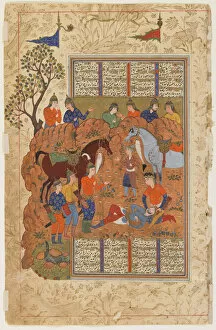Nasta Liq Script Collection
The "nasta liq script" is a captivating art form that beautifully captures the essence of Persian culture and history
All Professionally Made to Order for Quick Shipping
The "nasta liq script" is a captivating art form that beautifully captures the essence of Persian culture and history. Rustam's heroic act of kicking back the rock rolled on him by Bahman, as depicted in the Shahnama (Book of Kings), showcases bravery and resilience. In another stunning piece, Kai Khusrau is portrayed enthroned, holding a sword with regal elegance, showcasing power and authority. Moving forward in time, Emperor Babur's detached album folio from the late 19th century portrays his majestic presence through opaque watercolors. The intricate page of calligraphy from a 17th-century detached album folio adds an element of sophistication to this artistic journey. Kay Khusraw installing Luhrasp as king in 1493-94 demonstrates the rich historical narratives embedded within nasta liq script artwork. Zal's climb to reach Rudaba symbolizes determination and love overcoming obstacles. The arrival of the khaqan's daughter at Nushirwan's palace signifies diplomacy and cultural exchange between kingdoms. Iskandar comforting the dying Darab reflects compassion amidst turmoil. Intriguingly, Sa'di's complete works from 1515 showcase not only poetic brilliance but also exquisite inkwork blended with opaque watercolors and gold accents. The Beloved of Virtues manuscript from 1590-1600 captivates viewers with its delicate use of opaque watercolor and ink. A couple converse in an enchanting scene painted around 1450 using opaque watercolor and ink on paper, capturing human connection amidst beauty. Finally, the right-hand frontispiece from the Late Shahjahan Album transports us to Mughal India with its grandeur and attention to detail. Through these diverse artworks spanning centuries, nasta liq script reveals itself as a mesmerizing medium that encapsulates tales of heroism, love stories entwined with history, and the beauty of Persian calligraphy.













































